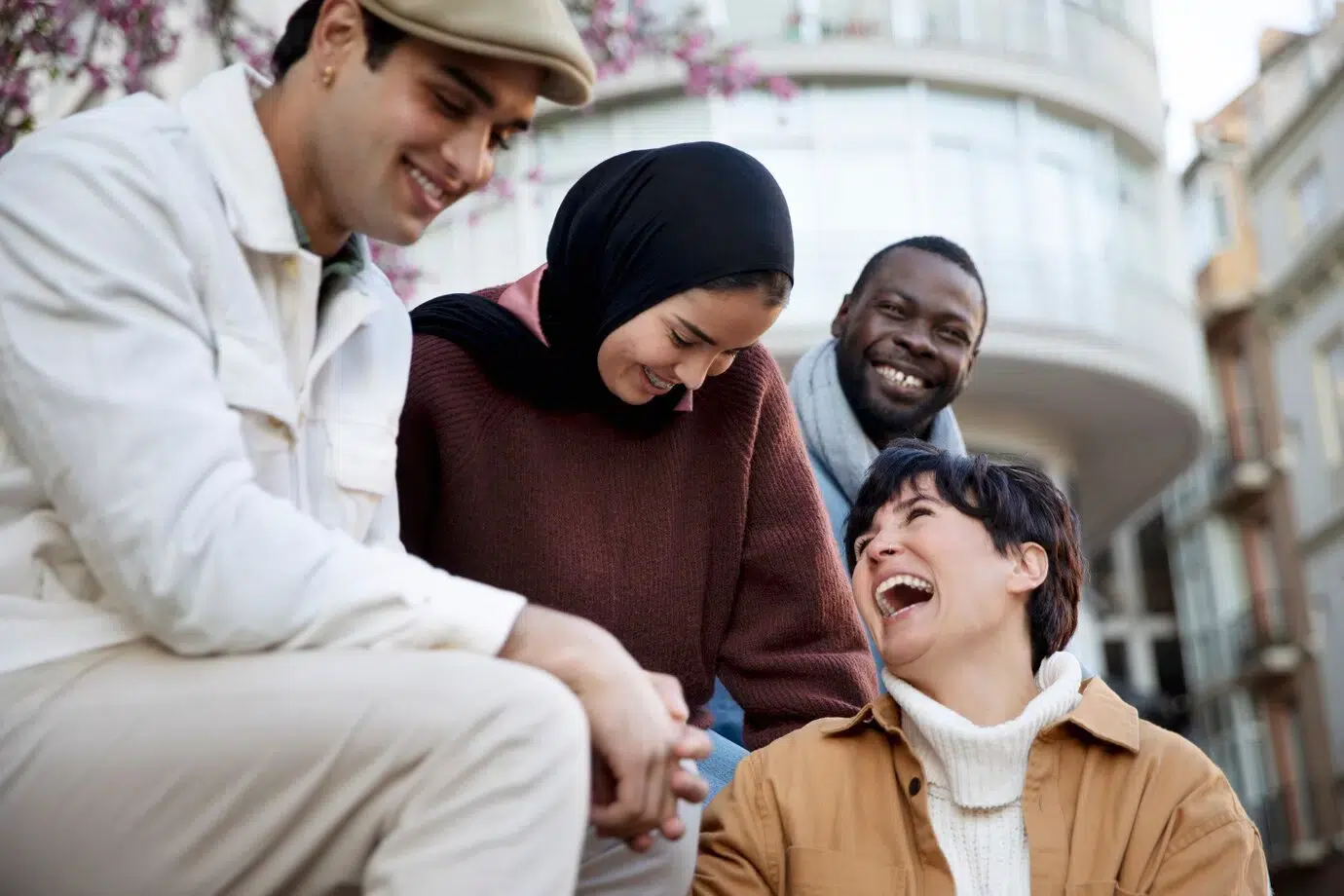Australia is a vibrant blend of cultures, where diverse traditions and languages come together.
When asking, “What language is spoken in Australia?” we uncover a fascinating aspect of the nation’s diversity.
The Australian Bureau of Statistics’ 2021 Census reveals that 27.6% of the population, or one in four people, were born overseas, each bringing their heritage and language to this country.

The Top Languages Spoken in Australia
Whilst English remains as the common language spoken by 72% of Australia’s population, there’s a notable portion of 22.3% of the population that speaks a language other than English at home.
Mandarin and Arabic boast large numbers of speakers across the country, with Vietnamese, Cantonese, and Punjabi also ranking among the top languages spoken.
Understanding this linguistic diversity is crucial. It not only allows us to appreciate Australia’s rich cultural landscape but also aids in connecting and communicating effectively with Culturally and Linguistically Diverse (CALD) communities.
Now, let’s have a closer look at these top 10 most spoken languages in Australia.
English
English is the dominant language in Australia, spoken by 18 million people.
Whilst it is not the official language of Australia by law, it is the de facto national language since the British settlement in 1778.
Australian English is known for its unique accent and colloquialisms. It is a distinct dialect that adds a distinctive Australian character to the global English language.
English is crucial in daily life in Australia. It serves as the primary language in education, government, and media, making it a key part of Australia’s culture and communication.
Mandarin
Mandarin is the second most spoken language in Australia, with 2.7% of the population choosing it as their home language. This reflects its significant presence in the nation’s linguistic mix.
The increase in Mandarin speakers is largely due to Chinese immigrants and international students in recent years.
Economic factors also play a role in this growth. Australia and China share strong economic and trade ties, as noted by the Australian Department of Foreign Affairs and Trade. These connections, along with community and cultural links, have created a favourable environment for Mandarin to thrive in Australia.
Arabic
The Arabic-speaking community in Australia, making up 1.4% of the population, is as diverse as the language itself. Speakers come from various parts of the Middle East and North Africa.
Historically, the rise of Arabic-speaking immigrants to Australia has been influenced by a range of factors. Political and social unrest in their home countries often led individuals and families to seek a new life in Australia.
Australia’s immigration policies, particularly after the Second World War, opened doors for people from Arabic-speaking nations.
Vietnamese
Over 300,000 Vietnamese speakers in Australia account for 1.3% of the population, making it the fourth most spoken language in the country.
The substantial presence of the Vietnamese community began with the primary wave of immigration in the aftermath of the Vietnam War during the late 1970s and early 1980s.
Many sought refuge from conflict and political instability, finding a new home in Australia. This migration reshaped Australia’s demographic fabric and brought a rich infusion of Vietnamese culture and traditions.
Cantonese
Cantonese, spoken by 1.2% of Australians, is the fifth most spoken language. Many of these speakers are concentrated in the bustling cities of Melbourne and Sydney.
Cantonese is primarily used in the Guangdong and southern Guangxi provinces of China, including the important cities of Canton, Hong Kong, and Macau.
The history of Cantonese in Australia dates to the 1850s when Cantonese-speaking immigrants were among the first Chinese communities to settle in the country in significant numbers.
Early Cantonese-speaking immigrants were among the first Chinese settlers. With their numbers growing significantly in the mid-20th century, they further established their community in Australia.
Punjabi
Punjabi is now spoken by over 230,000 people in Australia, making up 0.9% of the population. It is now the country’s fastest-growing language used at home in the country as reported by the 2021 Census.
About 74.3% of Punjabi speakers were born in India, whilst 21.8% were born in Australia. The largest Punjabi communities are found in Victoria, with New South Wales and Queensland following closely.
The language has a long history in Australia. It has been spoken continuously for 150 years, with documented Sikh records dating back to the late 1800s. This comes as no surprise as a large fraction of Punjabi speakers are from the Sikh religion.
Over the past five years, the Punjabi community has seen remarkable growth. This is largely due to the arrival of international students and skilled immigrants.
Greek
The Greek community in Australia is one of the most established and vibrant cultural groups, tracing its origins back to the early 20th century. Now, Greek is the seventh most spoken language in the country, representing 0.9% of the population.
From just seven young sailors in the 1800s to over 200,000 speakers today, the Greek community’s growth surged between the World Wars. The numbers continued to rise when Australia’s immigration policies became more welcoming.
Now, Australia’s Greek community is among the largest worldwide.
Italian
Like the Greek community, the Italian-speaking community is deeply rooted in Australia, with 0.9% of the population speaking Italian.
Italian immigrants came to Australia in large numbers, like the Greeks. They came from southern Italy, in the regions like Sicily, Calabria and Campania.
They arrived during the gold rush and continued to come after the Second World War. Many worked in cities, on farms, and in wineries. Their arrival marked the start of their significant influence on Australian life and culture.
Today, the impact of the Italian community is clear in many areas of Australian life from cuisine, art, language, and tradition.
Hindi
Hindi, spoken by nearly 200,000 people, is the ninth most spoken language in Australia. The 2021 Census data show that this is one of the fastest-growing languages. Most Hindi-speaking communities are in New South Wales and Victoria.
The Hindi-speaking community in Australia mainly comes from India. Their numbers have been growing driven by migrations through family connections, skilled migrants, and the arrival of international students.
The massive wave of Indian migration to Australia started in the 1980s. Today, Hindi speakers constitute 0.9% of Australia’s population, contributing to the country’s rich cultural diversity.
Spanish
Spanish is the tenth most spoken language in Australian homes, with over 170,000 speakers. Melbourne hosts the largest community of Spanish speakers, where 0.8% of the city’s population speaks the language.
Interestingly, about 25.3% of these Spanish speakers were born in Australia. This indicates the longstanding presence of Spanish communities since the early 20th century.
The arrival of Spanish speakers in Australia started in the 19th century but has picked up significantly in recent years. Various factors drive this migration, including higher education and job opportunities.
Recent migrants have been attracted by sectors such as mining, agriculture, defence, technology, and education, thanks to trade agreements. Most recent migrants come from Latin American countries like Colombia, Chile, and Argentina.
Comparison between 2016 and 2021 Census Data
Australia’s linguistic landscape has seen significant shifts from the 2016 to the 2021 Census, revealing notable changes in the top 10 most spoken languages in Australia.
Here are the key changes:

English continues to be the dominant language in Australia, with its speakers increasing by 17.5% from 2016 to 2021, bringing the total to 18 million English speakers in the country.
Now, let’s magnify our focus onto the languages most spoken in Australia after English.

• Punjabi is now Australia’s fastest growing language
Punjabi stands out as the fastest-growing language, with an 80.4% increase since 2016. It’s now the most popular language from the Indian subcontinent in Australia, surpassing Hindi and Nepali.
The community has grown to 239,033 speakers, with the majority born in India.
• Other Rapidly Growing Languages
Hindi has seen a 23.5% increase, with a significant number of speakers born in India and Fiji. In 2019 alone, over 14,000 Hindi speakers arrived in Australia.
Spanish has also seen notable growth of 21.7%. Among Spanish speakers, 25.3% were born in Australia, with many having parents from Colombia.
• Steady Growth in Other Languages
Mandarin speakers in Australia grew by 14.8%, with the community now exceeding 600,000 individuals according to the 2021 Census. The year 2019 saw the highest arrival of Mandarin speakers.
Arabic experienced a growth of 14.1%. Of the 367,159 Arabic speakers, 40.5% were born in Australia, predominantly to parents from Lebanon and Iraq.
Vietnamese remains the most popular Southeast Asian language spoken in Australian homes, with a 15.6% increase from 2016.
• The Slowing Growth of the Cantonese-Speaking Population
Cantonese saw a modest increase of 5.1%, indicating slower growth compared to other Chinese-speaking communities.
Although Australia has a large Cantonese-speaking community, the number of Cantonese speakers only grew by nearly 15,000 from 2016 to 2021.
• Decline in Greek and Italian-Speaking Populations
Greek and Italian are the only languages among the top 10 that have seen a decline since 2016. This trend is attributed to a decrease in migration from these countries.
The once large Greek and Italian-speaking community, established since the post-Second World War, have aged. With many passing away, these communities have not seen replenishment by younger generations, who mainly speak English now.
Conclusion
From all the information above, Australia truly is a hub of multiculturalism. The latest Census data reveals the dynamic interplay of languages at home, where 22.3% of Australians speak a language other than English.
From the rapid rise of Punjabi, now the fastest-growing language, to the significant increases in Hindi and Spanish speakers, Australia’s multicultural fabric is constantly evolving. Yet, as we see growth in these languages, we also observe a decline in the number of Greek and Italian speakers, signalling shifts in the community’s landscape.
This linguistic diversity enriches Australia. At the same time, it underscores the importance of fostering an inclusive environment for all. As Australia’s linguistic landscape continues to shift, the demand for language support and translation services are set to rise to ensure that all Australians have access to essential services, information, and opportunities regardless of the language they speak at home.
To learn more how Sylaba can assist in navigating Australia’s diverse linguistic needs, get in touch with our team today.
Related Posts

Get a quote today
"*" indicates required fields
Subscribe today to receive the latest insights and updates from Sylaba Translations







